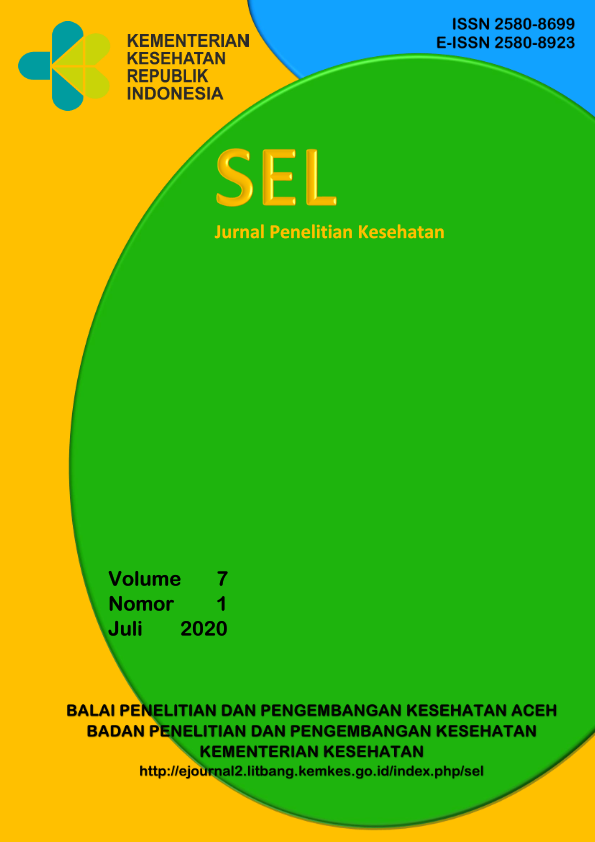PENGGUNAAN ENRICHMENT-SELECTIVE MEDIUM UNTUK MENINGKATKAN SENSITIFITAS PEMERIKSAAN LABORATORIUM DIFTERI
Abstract
Konfirmasi laboratorium kasus difteri dilakukan dengan isolasi dan tes toksigenisitas bakteri penyebab difteri menggunakan metode konvensional berbasis kultur. Metode konvensional memiliki keterbatasan dalam hal sensitivitas pemeriksaan. Penelitian ini bertujuan untuk menguji penggunaan darah domba + telurit sebagai enrichment-selective medium untuk meningkatkan sensitivitas pemeriksaan laboratorium difteri dengan metode konvensional. Sebanyak 18 spesimen klinis (swab tenggorok) penderita difteri digunakan sebagai sampel penelitian. Swab tenggorok tersebut sebelumnya telah digunakan untuk pemeriksaan Polymerase Chain Reaction (PCR) sehingga proses ekstraksi DNA menyebabkan jumlah sel bakteri yang tertinggal menjadi sangat terbatas. Sel bakteri tersebut ditumbuhkan menggunakan 2 cara yang berbeda, yaitu inokulasi langsung dan inokulasi yang didahului dengan penggunaan enrichment-selective medium. Hasil identifikasi bakteri penyebab difteri dibandingkan antara keduanya. Hasil penelitian menunjukkan bahwa inokulasi secara langsung hanya berhasil mengisolasi dan mengidentifikasi bakteri penyebab difteri (Corynebacterium diphtheriae) pada 3 dari 18 sampel yang diperiksa. Sebaliknya dengan penggunaan enrichment-selective medium, bakteri penyebab difteri berhasil diisolasi dan diidentifikasi pada 9 dari 18 sampel yang diperiksa. Oleh karena itu, disimpulkan bahwa enrichment-selective medium (darah domba + telurit) dapat digunakan untuk meningkatkan sensitivitas pemeriksaan laboratorium difteri.
Laboratory confirmation for diphtheria cases are performed by using conventional culture-based method for isolation/identification and toxigenicity of the bacteria causing diphtheria. This method has limitation in its sensitivity. This study aimed to examine the sensitivity of sheep blood + tellurite as the enrichment selective medium to improve the sensitivity of the conventional method. The samples were 18 clinical specimens (throat swabs) obtained from diphtheria patient, which had been used for Polymerase Chain Reaction (PCR) assay, therefore the DNA extraction process caused the number of bacteria cells to be very limited. The samples were cultured by two different methods, directly on the agar medium and indirectly through enrichment selective medium previously. The result showed that the directly inoculation could isolate C. diphtheriae as many as 3 out of 18 samples, whereas indirectly method by using enrichment selective medium could isolate and identify 9 out of 18 samples. In conclusion, enrichment selective medium (sheep blood + tellurite) may improve the examination sensitivity of bacteria causing diphtheria identification in the laboratory.
References
2. World Health Organization. Diphteria Reported Cases. 2019. http://www.who.int/immunization/monitoring_surveillance/routine/reporting/en/.
3. Directorate General of Disease and Prevention Control Ministry of Health RI. Integrated Surveillance for Disease that Can Be Prevented by Immunization. 2014:2014.
4. Mathur SB, Mukherjee SB. Diphteria Revisited. Indian Pediatr. 2017:411-412. https://indianpediatrics.net/oct2018/oct-903-904.htm.
5. Loganathan T, Bin Yusof MP. Adult Diphtheria in Malaysia: A Case Report. Med J Malaysia. 2018;73(5):340-341.
6. Puspitasari D, Ernawati, Husada D. Gambaran Klinis Penderita Difteri Anak di RSUD Dr . Soetomo (Clinical Features of Children with Diphtheria on Soetomo Hospital). 2012;(2):2012.
7. Pancharoen C, Mekmullica J, Thisyakorn U, Nimmannitya S. Clinical Features of Diphtheria in Thai Children: A Historic Perspective. Southeast Asian J Trop Med Public Health. 2002;33(2):352-354.
8. Udgaonkar U. Carrier Study and Treatment of Close Contacts : A Must for Diphteria Eradication. Indian J Med Microbiol. 2018;36(1):148. doi:10.4103/ijmm.IJMM
9. Sunarno, Kambang Sariadji, Holly Arif Wibowo. Potensi Gen dtx dan dtxR sebagai Marker untuk Deteksi dan Pemeriksaan Toksigenitas Corynebacterium diphtheriae. Buletin Penelitian Kesehatan. 2013;41(1):1-10.
10. Bhagat S, Grover SS, Gupta N, Roy RD, Khare S. Persistence of Corynebacterium diphtheriae in Delhi & National Capital Region (NCR). Indian J Med Res. 2015;142(October):459-461. doi:10.4103/0971-5916.169212
11. Meera M, Rajarao M. Diphtheria in Andhra Pradesh-A Clinical-Epidemiological Study. Int J Infect Dis. 2014;19(1):74-78. doi:10.1016/j.ijid.2013.10.017
12. Nakao H, Popovic T. Development of a Direct PCR Assay for Detection of the Diphtheria Toxin Gene. J Clin Microbiol. 1997;35(7):1651-1655. doi:10.1128/jcm.35.7.1651-1655.1997
13. World Health Organization. Vaccine Preventable Disease Surveillance Standards. https://www.who.int/immunization/monitoring_surveillance/burden/vpd/standards/en/. Published 2018.
14. Rouf A, Kanojia V, Naik H, Naseer B, Qadri T. An Overview of Microbial Cell Culture. J Pharmacogn Phytochem. 2017;6(6):1923-1928.
15. Kaur R, Wischmeyer J, Morris M, Pichichero ME. Comparison of Direct-Plating and Broth-Enrichment Culture Methods for Detection of Potential Bacterial Pathogens in Respiratory Secretions. J Med Microbiol. 2017;66(11):1539-1544. doi:10.1099/jmm.0.000587
16. Cho MC, Kim H, An D, et al. Comparison of Sputum and Nasopharyngeal Swab Specimens for Molecular Diagnosis of Mycoplasma pneumoniae, Chlamydophila pneumoniae, and Legionella pneumophila. Ann Lab Med. 2012;32(2):133-138. doi:10.3343/alm.2012.32.2.133
17. Sariadji K, Sunarno S, Khariri K, Puspandari N, Muna F, Rukminiati Y. Selektivitas Medium Cystine Tellurite Blood Agar (CTBA) terhadap Beberapa Isolat Bakteri. J Kefarmasian Indones. 2015;5(1):19-24. doi:10.22435/jki.v5i1.4082.19-24
18. Efstratiou A, Maple C. Manual for the Laboratory Diagnosis of Diphteria. Eur Reg World Heal Organ. 1994;47(1):33-41.
19. Jané M, Vidal MJ, Camps N, et al. A Case of Respiratory Toxigenic Diphtheria: Contact Tracing Results and Considerations Following A 30-Year Disease-Free Interval, Catalonia, Spain, 2015. Eurosurveillance. 2018;23(13):1-6. doi:10.2807/1560- 7917.ES.2018.23.13.17-00183
20. Sunarno, Sariadji K. Teknik Penyimpanan dan Prospek Transportasi Isolat Corynebacterium diphteriae Menggunakan Silica Gel. Biotek Medisiana Indonesia. 2017;6(2).
21. dos Santos LS, Antunes CA, dos Santos CS, et al. Corynebacterium diphtheriae Putative Tellurite-Resistance Protein (CDCE8392_0813) Contributes to The Intracellular Survival in Human Epithelial Cells and Lethality of Caenorhabditis elegans. Mem Inst Oswaldo Cruz. 2015;110(5):662-668. doi:10.1590/0074- 02760140479
22. Moran L, Kelly C, Cormican M, Mcgettrick S, Madden RH. Restoring the Selectivity of Bolton Broth During Enrichment for Campylobacter spp. From Raw Chicken. Lett Appl Microbiol. 2011;52(6):614-618. doi:10.1111/j.1472-765X.2011.03046.x
23. Hyeon JY, Park JH, Chon JW, et al. Evaluation of Selective Enrichment Broths and Chromogenic Media for Salmonella Detection in Highly Contaminated Chicken Carcasses. Poult Sci. 2012;91(5):1222-1226. doi:10.3382/ps.2011-01936
24. Yu YG, Wu H, Liu YY, Li SL, Yang XQ, Xiao XL. A Multipathogen Selective Enrichment Broth for Simultaneous Growth of Salmonella enterica serovar enteritidis, Staphylococcus aureus, and Listeria monocytogenes. Can J Microbiol. 2010;56(7):585- 597. doi:10.1139/W10-040
25. Cartwright CP, Stock F, Gill VJ. Improved Enrichment Broth for Cultivation of Fastidious Organisms. J Clin Microbiol. 1994;32(7):1825-1826.doi:10.1128/jcm.32.7.1825-1826.1994
Copyright (c) 2020 Sel Jurnal Penelitian Kesehatan

This work is licensed under a Creative Commons Attribution-NonCommercial-ShareAlike 4.0 International License.






